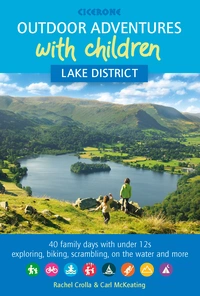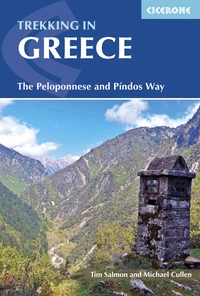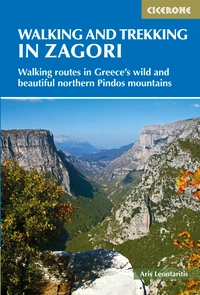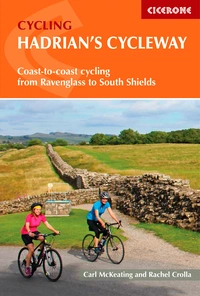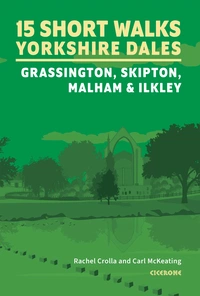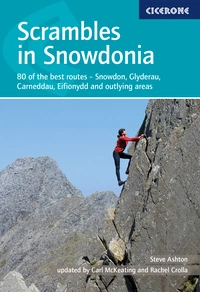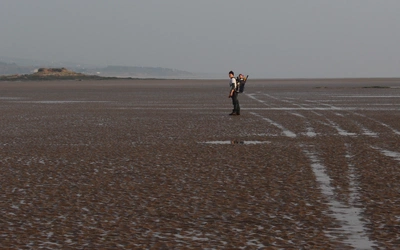In the realm of the wildcat: A hike with children up Mount Ida
Carl McKeating and Rachel Crolla, the authors of Europe’s High Points and Outdoor Adventures with Children, hiked up Crete’s Mount Ida with their two young daughters. There were a few unexpected distractions on the way.
‘It’s out here somewhere,’ I said, watching our two daughters – one seven, the other four – eagerly scan the dry and rocky white mountainsides that enveloped us. There had been little signs of life – two mountain goats, a couple of lizards, one bee, no people other than ourselves – nothing to suggest the existence of the once mythological felis silvestris creticus, the Cretan wildcat. The Cretan wildcat was long considered a mythic product of folklore and shepherds’ fancy. Then in 1996 a team from the University of Perugia surprised everyone – including themselves – by accidentally trapping one. Little is known about the animal, although some scientists feel it may have been on Crete before it separated from the mainland, while others have suggested it was brought to the island by Phoenicians around 1000BC.
Our children’s hunt for this rarest of rare beasts was proving a welcome distraction from the awkward terrain of angular karstic, dolomite and marble rocks underfoot and scratchy thorn bushes bordering our path. Ascending to the high point of Crete was not proving easy. Our route required a round trip of over 10 miles and 1200m of ascent on tricky ground that was conducive only to slow passage. We would not have wanted it any other way; after all, as every hiker knows, there is nearly always added satisfaction in a summit hard won.
For just over 10 years from the mid-nineties to the mid-noughties, Rachel Crolla and I made a habit of going to the highest point of countries we visited on holiday – many of those summits had been hard won. Nonetheless, the habit became an obsession and resulted in our ascending to the highest point of every country in Europe and writing a guide book about the collection of peaks. It seems with us old habits die hard, for this ascent of Mount Ida – a famed mountain of the classical era that is now known by the Cretans as Psiloritis – was very much in our old high-pointing tradition, despite Crete last being an independent country in 1908 and the logistics of such an undertaking with children now complicating things.
Geographical disputes
Mount Ida is also disputed as the island’s high point – not particularly convincingly – but nonetheless it reminded us of the many geographical disputes that Europe’s national high points had generated. Our high points pursuit always had an arbitrary logic: a quirky meeting of politically designated space and measured topographical finitude. And yet our desire to reach these national high points had impelled us to visit some of the most beautiful, diverse and interesting places in Europe. In doing so countless adventures had come our way. Today was to prove no different.
Despite waking early, several helpings of breakfast and a long drive had ensured it was late morning by the time we reached the trailhead. It was eerie. A large unfinished refuge complex bordered a vast empty parking area. The logic behind the complex had long since been lost. This incongruous white structure overlooking the verdant Nida Plateau now functioned as little more than a ghostly monument to misguided mountain tourism; its windows boarded or missing, its vast interiors supported by rusted acroes, its floor dusty with split bags of cement. A splay of shattered car window glass beside it suggested either petty crime or – optimistically perhaps – someone who had locked their keys in their vehicle. A feeling of unease crept over me. When looking back on continental mountain trips I tend to forget those anxious moments before the umbilical cord connecting us to civilisation was cut so that the wildness of mountains could be embraced. On a massive four-month high point collecting trip in 2005 we left our car behind at various back-end-of-nowhere trailheads, among them the starting points for Moldeveanu in Romania, Maglic in Bosnia and Djeravica in Kosovo. Sometimes ascending into remote mountains we would catch a last view of our car and wonder if it would be stripped bare or there at all when we returned. The rewards of mountains often require an acceptance of different kinds of jeopardy, but going up mountains with children makes you keen to avoid it if at all possible.
After enjoying some initial child-friendly scrambling on the rugged path and gaining a couple of hundred metres of height, I heaved our youngest daughter into the back carrier, conscious of the limited daylight hours of late October and perhaps intent on wrecking my back. She promptly fell asleep while I carried her up a shallow ravine into the calm silence of the mountain. On her waking an hour later, she yawningly murmured: ‘I’m hungry; is it dinnertime yet?’
Hard-won progress
We regrouped to eat a morale-boosting picnic made – somewhat surreptitiously – from the offerings of the hotel’s breakfast buffet. Soon after, we reached a col at 1900m. A sprawl of raised peaks with no hint of Mount Ida’s summit stood before us. While our oldest daughter explored a roofed drystone shelter just about big enough to accommodate four people sitting up, Rachel and I assessed our progress. Despite having worked hard, we had covered only one third of the trail to the summit. Added to this, a demoralising descent was now necessary to access the next protracted ravine through which our boulder-strewn and thorn-bordered path would gradually climb. We had little studied the route before setting off, content that we had a basic overview map and route description, plenty of food and water, additional clothes, excellent weather and a path that was well-marked with red painted dots. Now we questioned whether the summit was a realistic proposition.
Yet we also knew we could rely on our oldest daughter’s phenomenal endurance and undiminishable supply of second winds. Thus we pressed on, captured as we all were by that timeless lure of the mountain top.
Much later in the day than we had hoped we reached a col that finally allowed the top of Mount Ida with its summit chapel to be seen. We also discovered a string of eight or so distant hikers descending from it. At first perplexed as to how they had got there, we soon established they were a guided group who had ascended from a refuge on the north side of the mountain. It appeared that a tour company had made the refuge accessible by 4x4 and helped to construct a new and much easier path. Their ascent demanded only a fraction of the effort. It reminded me of reaching the top of Zugspitze, the highest mountain in Germany. Our route on Zugspitze was spectacular, requiring the crossing of a glacier and more than 2000m of exposed vertical ascent, much of which was on via ferrata, although we could have simply taken a cable car to the bustling station situated near the summit. Yet for the true hiker, there is reward in the road less travelled.
As we pushed on towards Ida’s summit we were joined by a large bird of prey. It circled the astral sky just above our heads, tipping its wing to glide effortlessly back and forth, swooping beneath us to catch air currents rising up the vertiginous mountainside that we now traversed. We assumed it was an eagle, but discovered later it was a griffon vulture – an endangered species. Surprisingly for a ‘vulture’, the bird was beautiful.
For the final climb to the summit I unloaded our youngest daughter. She promptly raced on to join her older sister at the top. Both were delighted to find a large bell that they could ring free-standing beside the summit chapel of the Holy Cross. The chapel is a famous site for Cretans, perhaps made more so by Nikos Kazantzakis, author of Zorba the Greek and The Last Temptation of Christ, who claimed that he lost his virginity in it. The day was late now; Rachel and I were resigned to benightment. That resignation was helpful. We did not rush the children on the summit while they ate another picnic or while they explored the chapel in which they each lit a candle. Our acceptance of the inevitable night hiking to come allowed us time to register the brilliance of Ida’s airy summit space. Both the north and south sides of the island were visible.
In the south the sun-gilded rolling waves of the Mediterranean stretched to a distant horizon – it seemed ethereal.
Before leaving we carefully climbed onto the roof of the chapel, with little more reason than to feel the sky could offer the only full stop to our ascent.
Keep moving
Much to our astonishment, our youngest daughter coped amazingly well with the awkward terrain of the protracted descent and I had no need to use the carrier; a welcome result for my back and shoulders. The day had only a limited tail; the sun lowered to the horizon and bowed out with a broad magenta flourish leaving a family of four hiking in the twilight while playing name that tune. Although the hiking would have been challenging enough without children, I felt weightless, enthralled by the surreal nature of our excursion. We were submerged in an inky darkness with a third of the descent still to go. Given the difficulty of the descent I suppose many families would have found this predicament a little stressful; they may even have contemplated sitting out the night in the tiny rudimentary shelter which we passed once more at the 1900m col – a mistake of course, it is important to keep moving. Yet both Rachel and I felt calm, secure in our experience born from countless excursions.
We steered a methodical course homewards, our children loving every step of the adventure, testing their night vision until head torches needed to be donned.
The night was crystal clear and, although the head torches were an obligatory precaution, we could have managed by the light of the full moon which rose fiery – first amber, then gold – before bathing our course in silver-white light. The Idean Cave where, according to mythology, Zeus was hidden from his father Kronos, lay just off of our route. We had not had time to visit it, but such mythology seemed apt – during our descent there seemed a presence or something supernatural about the mountain.
Back at the car we were surprised to discover the temperature was 3 degrees C (I was still in shorts), although not surprised to find it was 9pm.The children, excited by their adventure, requested Queen’s Greatest Hits II for the journey back down the mountain and so it was to the sound of I Want to Break Free that, having driven only part of the way down the mountain, I was startled by an animal in the headlights. ‘Look, a badger,’ I exclaimed – although immediately realising I was wrong. Rachel, also watching the creature run across the road and disappear into the night said: ‘That’s no badger.’ Despite our disbelief, this was an encounter with a Cretan wildcat. On mountains, if nowhere else, wonders never cease.

